The Anti-pollution Toner Market is estimated to be valued at USD 586.1 million in 2025 and is projected to reach USD 982.3 million by 2035, registering a compound annual growth rate (CAGR) of 5.3% over the forecast period.
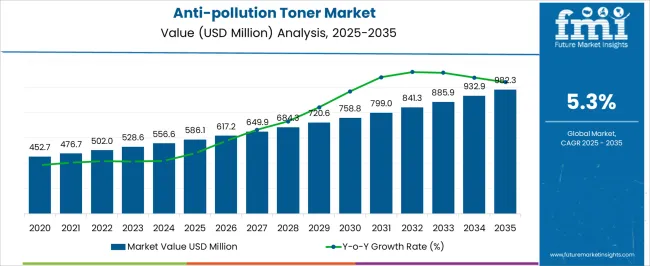
| Metric | Value |
|---|---|
| Anti-pollution Toner Market Estimated Value in (2025 E) | USD 586.1 million |
| Anti-pollution Toner Market Forecast Value in (2035 F) | USD 982.3 million |
| Forecast CAGR (2025 to 2035) | 5.3% |
The anti pollution toner market is gaining steady traction due to increasing concerns over skin health linked to rising pollution levels in urban environments. Consumers are becoming more aware of the impact of airborne toxins, fine dust, and heavy metals on the skin barrier, driving demand for skincare products that offer protective and detoxifying benefits.
Dermatological research highlighting the correlation between pollution exposure and premature aging, inflammation, and acne has further strengthened market growth. The market is also benefiting from expanding product formulations enriched with antioxidants, botanical extracts, and pollution neutralizing compounds.
As clean beauty trends continue to influence purchasing behavior, brands are increasingly investing in transparent labelling and eco friendly ingredient sourcing. The outlook remains positive as urban populations seek preventative skincare solutions that address environmental stressors while aligning with health and wellness priorities.
The market is segmented by Nature, Consumer Orientation, End use, and Sales Channel and region. By Nature, the market is divided into Conventional and Natural/ Organic. In terms of Consumer Orientation, the market is classified into Men, Women, and Unisex. Based on End use, the market is segmented into Residential and Commercial. By Sales Channel, the market is divided into Hypermarkets/ Supermarkets, Convenience Stores, Specialty Stores, Salon Stores, Online Retailing, Pharmaceutical & Drug Stores, and Others. Regionally, the market is classified into North America, Latin America, Western Europe, Eastern Europe, Balkan & Baltic Countries, Russia & Belarus, Central Asia, East Asia, South Asia & Pacific, and the Middle East & Africa.
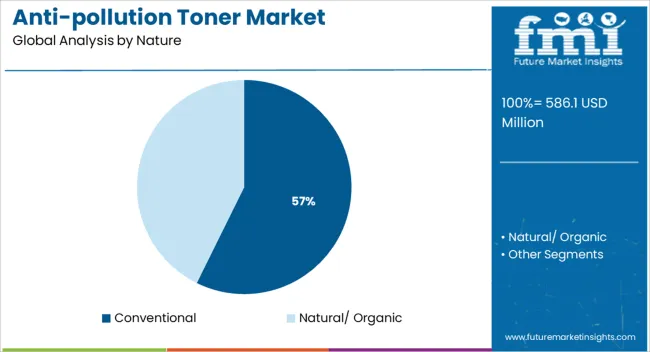
The conventional segment is projected to contribute 57.30% of total market revenue by 2025 under the nature category, positioning it as the dominant segment. This leadership is supported by its widespread availability, cost effectiveness, and established consumer trust in long standing skincare formulations.
Conventional anti pollution toners are often backed by dermatological testing, offer a broad range of product variants, and are distributed through mainstream retail and e commerce channels. Their accessibility and affordability across mass market and premium tiers have enhanced penetration, particularly in emerging economies.
While organic and natural segments are gaining interest, conventional formulations continue to dominate due to their performance consistency, extended shelf life, and brand familiarity.
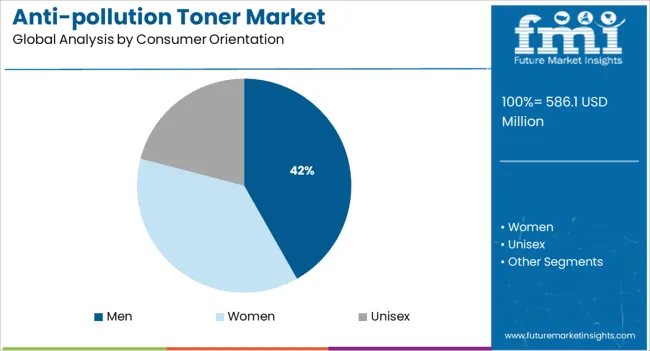
The men segment is expected to account for 41.80% of total market revenue by 2025 within the consumer orientation category, establishing itself as a key growth driver. Increased grooming awareness, rising disposable income, and targeted marketing campaigns have contributed to greater skincare adoption among male consumers.
Urban male demographics, particularly those exposed to pollution and occupational skin stress, are actively seeking functional products that offer cleansing and protective benefits. The simplification of skincare routines through all in one solutions and minimalistic packaging has also boosted appeal.
As brands expand their men specific product lines and invest in influencer driven awareness strategies, the male consumer base continues to expand, solidifying this segment’s growth trajectory.
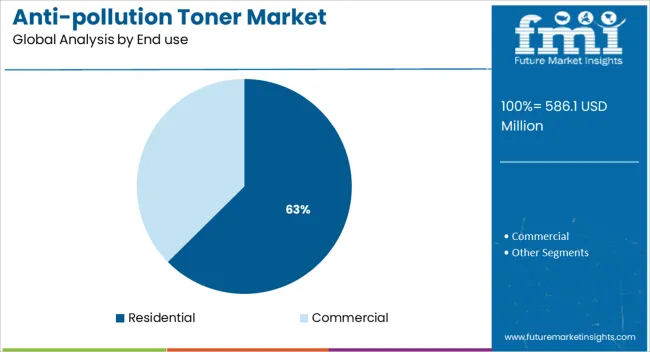
The residential segment is anticipated to capture 62.60% of total market revenue by 2025 under the end use category, confirming its role as the dominant usage environment. Increased at home skincare practices and growing consumer preference for self care routines have elevated product usage frequency in residential settings.
The widespread adoption of anti pollution toners as part of daily regimens is supported by the convenience of at home application, particularly in the context of remote work and hybrid lifestyles. Additionally, the proliferation of online retail platforms has made it easier for consumers to access a variety of toner products tailored to individual skin concerns.
The residential segment’s leadership is also driven by growing awareness campaigns, DIY skincare trends, and the normalization of self care rituals, all contributing to sustained demand across diverse demographics.
As per FMI, the global market for anti-pollution toners is expected to grow at a steady CAGR of 5.3% between 2025 and 2035, reaching a valuation of USD 982.3 million by the end of 2035. The rising prevalence of skin allergies triggered by pollutants, the growing popularity of natural skin care products, and increasing consumer spending on personal care & cosmetics are some of the key factors boosting sales of anti-pollution toners.
Concerns over pollution have risen to the top of the global agenda in recent years. Pollution has a higher impact in major cities, and inhabitants are concerned about the negative impacts it has on their skin and health. As a result, anti-pollution toner demand is growing substantially.
Air pollution, according to the World Health Organization, has a massive impact not only on one's health but also on one's skin. As fine dust levels have grown considerably in recent years, anti-pollution toner has become vital in many households across the world.
Customers are increasingly interested in anti-pollution toner because of the multiple benefits it provides. A number of personal care enterprises are gaining momentum as a consequence of the increased need for anti-pollution toners.
With growing pollution levels, there is a large demand for anti-pollution toners that can protect and cleanse the skin. Furthermore, businesses that offer anti-pollution toners employ a range of marketing methods to attract clients who wish to avoid damage by hazardous air.
Rising Trend of Self-care Creating Opportunities for Anti-pollution Toner Manufacturers
The growth in self-care tendencies has had a significant impact on consumer psychology. People are seeking modest items that do not require a large expenditure. As an example, a product or service that provides immediate comfort, such as revitalizing with a face mask or foot bath. These minor incentives are here to stay. It will have a potentially long-term influence on companies and the items that people purchase.
Personalization is now more crucial than it was a few years ago. People want more natural, organic, and pure solutions, and the demand is growing by the day. Marketers must consider this big shift in customer perception while developing long-term and short-term company objectives.
They will need to rethink their current method and choose a more customized and inventive approach that not only meets customer needs but also improves the final result, such as how the experience may assist them to add value to their new way of living. Brands must step up their game with innovative solutions and capitalize on the opportunities presented by the changing customer mindset.
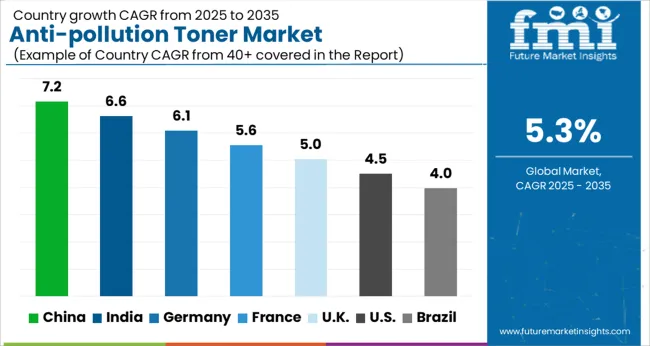
High Demand for the Anti-Pollution Cosmetics Making China a Lucrative Market
As per FMI, China is estimated to account for more than 60.0% of the East Asia anti-pollution toner market in 556.60556.6556.6. Further, sales of anti-pollution toners in the country are likely to rise at a steady pace during the next ten years owing to the rising consumer spending on skin care cosmetics and easy availability of low-cost anti-pollution toners.
Similarly, growing pollution levels in areas like Beijing and Hebe are prompting Chinese consumers to choose anti-pollution skin care products, such as anti-pollution toners. This will continue to boost sales during the forecast period.
Chinese customers are not only looking for skin care products, but also for goods that may protect their hair from the harmful effects of pollution. These products have been in high demand since 556.6019, as pollution in the nation has increased and people have become more aware of the harmful consequences and skin issues caused by pollution.
In addition to this, increasing export of skin care products across the country will continue to generate lucrative opportunities for anti-pollution toner manufacturers over the next decade.
Increasing Consumer Spending on Personal care and Cosmetics Booting Market in Vietnam
The skin care market in Vietnam is relatively new, yet it is among the most vibrant in the nation. As Vietnam's standard of living improves, Vietnamese customers are increasingly utilizing personal care and cosmetic products in addition to meeting fundamental necessities. Skincare products are significant in Vietnam, with a market value of around more than USD 556.6 billion in 556.60556.61.
The sector is thriving as a result of a huge number of Vietnamese consumers spending on personal care and cosmetic goods as their standard of living improves. Vietnam has progressed to be a middle-income country, with an expanding middle class that is dedicating more of its resources to skin care goods.
Growing disposable income, changing standards of beauty, the expansion of social media, etc., all contribute to Vietnam's strong demand for beauty goods. Since 556.6018, the percentage of women who use skin care has risen from 10% to 556.60% and is predicted to rise at a similar rate during the projection period, creating prospects for anti-pollution toners.
Rising Pollution Generating High Demand for Anti-pollution Toners in India
According to Future Market Insights, India might control more than 556.65% of the South Asia market by 556.60556.6556.6 and further expand at a moderate CAGR over the next decade. This can be attributed to the rising pollution levels in the country, growing health awareness, and easy availability of a wide range of anti-pollution products at affordable prices.
In recent years, anti-pollution toners have gained immense traction across India owing to consumer worries about unsafe levels of air toxicity in India's metropolitan markets and the growing incidence of skin allergies. This will continue to create prospects for manufacturers.
Growing Consumer Preference for Chemical-free Products Pushing Demand
During the projection period, the natural/organic category is expected to grow at a prolific CAGR of around 10%. This can be attributed to the rising consumer preference for skincare products with natural ingredients.
Because of rising consumer awareness and desire for chemical-free natural skin care products, cosmetic firms have prioritized the creation of organic products with lower environmental impact and more social benefits, creating even more prospects.
Customers who previously used conventional skin care products have moved to natural and herbal items because of such product innovation. This will play a key role in expanding the global anti-pollution toner industry.
Women Category to Hold a Major Share in the Market
According to FMI, in terms of consumer orientation, the women segment is predicted to have a significant share of about 40% by 2025. This can be attributed to the rising usage of antipollution toner by women folk globally.
Rising pollution levels, as well as an increase in skin-related disorders such as sensitive skin and acne among women, will further boost sales during the forecast period. The rise in women's workforce has increased females' exposure to pollution and potentially hazardous chemicals. In order to protect their skin from this pollution, they use anti-pollution toners. While it is also seen that female consumers are more conscious about their skin health and appearance as compared to men.
Online Retailing to Generate Highest Revenues
Based on sales channels, the online retailing segment is likely to generate the highest revenues during the forecast period. This can be attributed to the rising penetration of the internet and increasing consumer preference towards purchasing skin care products through online shopping platforms.
Various online retailing platforms provide a large choice of items at reduced costs, enticing people to buy anti-pollution toners online. This will accelerate the growth of the target segment during the projection period.
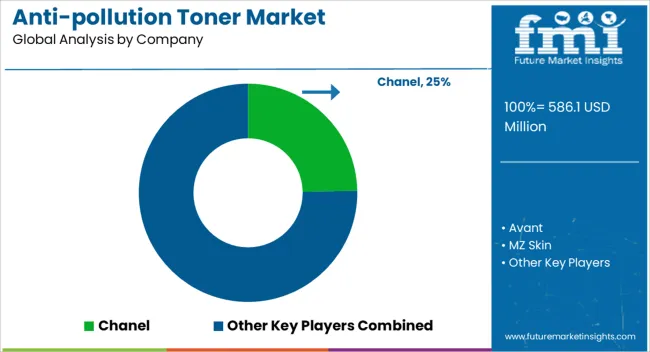
Companies operating in the anti-pollution toners market are aiming at developing new products to expand their product portfolio as well as to meet growing consumer demands. Besides this, they are spending rigorously on advertising and promotional activities to expand their customer base.
For instance,
| Attribute | Details |
|---|---|
| Estimated Market Size (2025) | USD 586.1 million |
| Projected Market Size (2035) | USD 982.3 million |
| Anticipated Growth Rate (2025 to 2035) | 5.3% |
| Forecast Period | 2025 to 2035 |
| Historical Data Available for | 2020 to 2024 |
| Market Analysis | USD Million for Value |
| Key Regions Covered | North America; Latin America; Europe; East Asia; South Asia; Oceania & MEA |
| Key Countries Covered | United States, Canada, Brazil, Mexico, Germany, UK, France, Spain, Italy, Russia, South Africa, Northern Africa GCC Countries, China, Japan, South Korea, India, Thailand, Malaysia, Indonesia, Australia & New Zealand |
| Key Segments Covered | Nature, Consumer Orientation, End Use, Sales Channel, and Region |
| Key Companies Profiled | Chanel; Avant; MZ Skin; Dermatouch; Simple; Bioderma; Earth Harbor; Biotherm; Cinq Monde; Sabon; Sephora; Detoxie; Active Beaute; Hydra Sheild; Others |
| Report Coverage | Market Forecast, Company Share Analysis, Competition Intelligence, DROT Analysis, Market Dynamics and Challenges, and Strategic Growth Initiatives |
The global anti-pollution toner market is estimated to be valued at USD 586.1 million in 2025.
The market size for the anti-pollution toner market is projected to reach USD 982.3 million by 2035.
The anti-pollution toner market is expected to grow at a 5.3% CAGR between 2025 and 2035.
The key product types in anti-pollution toner market are conventional and natural/ organic.
In terms of consumer orientation, men segment to command 41.8% share in the anti-pollution toner market in 2025.






Our Research Products

The "Full Research Suite" delivers actionable market intel, deep dives on markets or technologies, so clients act faster, cut risk, and unlock growth.

The Leaderboard benchmarks and ranks top vendors, classifying them as Established Leaders, Leading Challengers, or Disruptors & Challengers.

Locates where complements amplify value and substitutes erode it, forecasting net impact by horizon

We deliver granular, decision-grade intel: market sizing, 5-year forecasts, pricing, adoption, usage, revenue, and operational KPIs—plus competitor tracking, regulation, and value chains—across 60 countries broadly.

Spot the shifts before they hit your P&L. We track inflection points, adoption curves, pricing moves, and ecosystem plays to show where demand is heading, why it is changing, and what to do next across high-growth markets and disruptive tech

Real-time reads of user behavior. We track shifting priorities, perceptions of today’s and next-gen services, and provider experience, then pace how fast tech moves from trial to adoption, blending buyer, consumer, and channel inputs with social signals (#WhySwitch, #UX).

Partner with our analyst team to build a custom report designed around your business priorities. From analysing market trends to assessing competitors or crafting bespoke datasets, we tailor insights to your needs.
Supplier Intelligence
Discovery & Profiling
Capacity & Footprint
Performance & Risk
Compliance & Governance
Commercial Readiness
Who Supplies Whom
Scorecards & Shortlists
Playbooks & Docs
Category Intelligence
Definition & Scope
Demand & Use Cases
Cost Drivers
Market Structure
Supply Chain Map
Trade & Policy
Operating Norms
Deliverables
Buyer Intelligence
Account Basics
Spend & Scope
Procurement Model
Vendor Requirements
Terms & Policies
Entry Strategy
Pain Points & Triggers
Outputs
Pricing Analysis
Benchmarks
Trends
Should-Cost
Indexation
Landed Cost
Commercial Terms
Deliverables
Brand Analysis
Positioning & Value Prop
Share & Presence
Customer Evidence
Go-to-Market
Digital & Reputation
Compliance & Trust
KPIs & Gaps
Outputs
Full Research Suite comprises of:
Market outlook & trends analysis
Interviews & case studies
Strategic recommendations
Vendor profiles & capabilities analysis
5-year forecasts
8 regions and 60+ country-level data splits
Market segment data splits
12 months of continuous data updates
DELIVERED AS:
PDF EXCEL ONLINE
Global Toner Pads Market Size and Share Forecast Outlook 2025 to 2035
Destoner Machine Market Trend Analysis Based on Product Type, End-Use, Automation, and Region 2025 to 2035
AHA Toners Market Size and Share Forecast Outlook 2025 to 2035
Skin Toner Market Size and Share Forecast Outlook 2025 to 2035
Printing Toners Market Size and Share Forecast Outlook 2025 to 2035
Beverage Cartoners Market Size and Share Forecast Outlook 2025 to 2035
Witch Hazel Toners Market Size and Share Forecast Outlook 2025 to 2035
Glycolic Acid Toners Market Analysis - Size, Share, and Forecast Outlook 2025 to 2035
Wrap Around Cartoners Market Size and Share Forecast Outlook 2025 to 2035
Continuous Motion Cartoner Market Size and Share Forecast Outlook 2025 to 2035
Flexible End-Load Cartoner Market Size and Share Forecast Outlook 2025 to 2035

Thank you!
You will receive an email from our Business Development Manager. Please be sure to check your SPAM/JUNK folder too.
Chat With
MaRIA